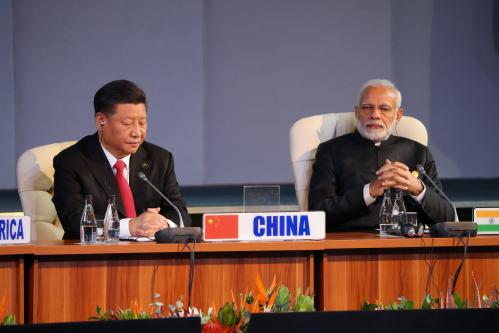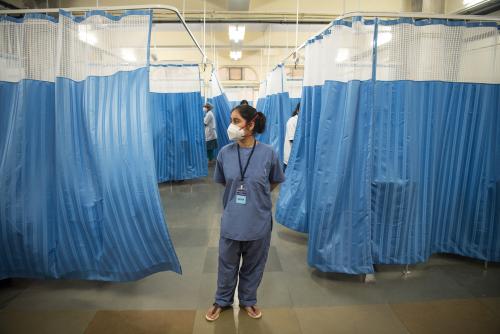

Past Event
Content from the Brookings Institution India Center is now archived. After seven years of an impactful partnership, as of September 11, 2020, Brookings India is now the Centre for Social and Economic Progress, an independent public policy institution based in India.
By David Dam, Akshata Mishra and Manasvi Hemmige
As we stepped into 2019, a key election year for India, Brookings India hosted a series of roundtables with Tufts University on the opportunities that lie ahead for the world’s largest democracy in healthcare and geopolitics, two areas where we face significant challenges.
The day-long programme brought together academics, researchers and experts from Tufts University and India to discuss how India can address challenges in healthcare and human capital and what innovative approaches it can adopt to advance its interests at home and abroad at a time marked with growing uncertainty and shifting power structures.
Vikram Singh Mehta, Chairman of Brookings India, made the opening remarks and reiterated Brookings commitment to research that focuses on India’s unique problems and finding practical, evidence-backed solutions.
Anthony Monaco, President of Tufts University hoped to form partnerships and raise awareness in India about the work being done by Tufts University to make the world a brighter place. He also emphasised Tufts’ commitment to a global perspective on making a positive impact to society as so many of the challenges cross national borders as must their solutions.
India’s approach can deal with the shifting burden of disease
Panelists: Harris Berman, Dean, Tufts University School of Medicine; Honorine Ward, Professor of Medicine at Tufts University School of Medicine; K. Srinath Reddy, President, Public Health Foundation of India and Shamika Ravi, Director of Research, Brookings India.
Moderator: Deborah Kochevar, Provost ad interim, Tufts University.
At the first panel discussion of the day, scholars and experts from Brookings, Tufts University and the Public Health Foundation of India (PFHI) discussed the potential challenges India faces in the areas of public health, finance, and research.
India contains 18 percent of the world’s population, and while the disease burden of the country has shifted towards non-communicable diseases such as diabetes and cardiovascular issues, state health levels vary widely.
Shamika Ravi, Research Director at Brookings India, and a Senior Fellow with the Brookings Institution, emphasised that one of India’s main challenges is that out-of-pocket burden in healthcare remains significantly high. In India, the out of pocket health burden was 67 percent, which has now fallen to 63 percent, but still much higher than other countries, such as Thailand that stands at 11 percent or China at 36 percent. Second, 70 percent of the country is at risk of falling below the poverty line because of a health shock that results in catastrophic health expenses. Because each state is very different, problems exist on the level of governance between states, where better governed states have made immense progress and experimentation with different systems.
Ravi argued that healthcare should be a policy priority as it was closely linked to governance; for example, in the more progressive southern states, around 75 percent of the population relies on public healthcare system across quintile groups — clearly indicating that public care is working in those states. In less developed states such as Uttar Pradesh and Bihar, 15 percent across quintile groups of the population relies on public healthcare.
One of the key healthcare reforms has been the introduction of Ayushmaan Bharat (PMJAY) in August 2018. Key components of Ayushmaan Bharat include coverage for nearly 40 percent of the population while expanding primary, preventative healthcare networks. Moving forward, India faces potential challenges in the areas of public health, finance, and research.
Dr. Harris Berman, Dean at the Tufts University School of Medicine, who has observed India for over 50 years as a part of the Peace Corps and travelled across the country to observe its medical system, reflected on the advances India has made. Population control, communicable and infectious diseases such as typhoid and smallpox were some of the challenges that India took head on, though they still persist.
Dr. Honorine Ward, Professor of Medicine at Tufts University School of Medicine, emphasised that one India’s continuing challenges is malnutrition and stunting. Her work focuses on the causes behind stunting and why vaccines don’t work in India, with malnutrition being the baseline. One of the possible reasons discovered is the alterations in microbiomes, research of which has been funded by the NIH, Bill and Melinda Gates Foundation.
While the entire country has shifted towards non-communicable diseases as a growing health burden, there are huge variations within each state on their burdens of disease. Dr Srinath Reddy, President of the Public Health Foundation of India, highlighted that social determinants, such as wealth and education, play a role in each state’s disease burden. Even when the more advanced states have seen burdens of diseases shift toward non-communicable diseases, infectious diseases still remain public health issues, especially in the realm of drug-resistant microbes.
Other public health issues include the usage of tobacco within the country, where taxation could be better at reducing the incentives to smoke. The panel agreed that air pollution has grown in importance as a public health issue, but tackling such a problem is multifaceted, and requires states to tackle these challenges as well. Other determinants include the consumption of fast foods, soft drinks, and other poor nutritional habits.
India is also at a crossroads in terms of funding challenges. Learning from the U.S., insurance as a financing instrument creates moral hazard and adverse selection problems and little incentives to cut costs. The U.S. spends almost 20 percent of its gross domestic product (GDP) on health to achieve similar health outcomes to other countries that spend far less, which suggests any insurance schemes in India should proceed with caution. Public financing of healthcare in India is only around 20 to 30 percent, which makes universal health coverage a difficult order. But innovations going on in terms of technologies allow the potential to scale up coverage and accessibility.
India’s rural and urban divide also pose challenges for its healthcare system. 75 percent of healthcare infrastructure is located in urban areas, which makes costs higher for travel and logistics more of a burden. Brazil had great community health teams that were highly engaged in rural areas, and similar teams could extend better care and coverage to rural communities. While rural and urban health burdens are different, the urban slums sometimes show conditions far worse than rural areas with the emergence of lean diabetes.
Recent reforms have shown that healthcare is finally a priority for the government, indicating electoral firepower behind the country’s health needs. While innovations in secondary and tertiary care have grown drastically due to their profit margins, the government needs to increase its role in preventative and primary care which face lower margins and are the basis of all care. To do so, the government must keep several challenges in mind, such as allowing flexibility between states, and targeting the vulnerable populations that these programs seek to serve.
Investing in India’s human capital
Keynote address: Junaid Kamal Ahmad, Country Director, World Bank.
Discussants: Shamika Ravi, Research Director, Brookings India; Bhaskar Chakravorti, Dean, Global Business, Tufts University.
In the second discussion of the day, the focus shifted to human capital, and how India needs to invest in the health, well-being and capabilities of its people, if it wants to realise its dreams of becoming a global power.
In his keynote address Junaid Kamal Ahmad, Country Director, World Bank, outlined the three key areas where India needs to redouble its efforts. These essential components of human capital are: the ability to survive to the age of five, the creation of learning-adjusted schooling and healthy and non-stunted growth in children before they reach adolescence.
Findings by the World Bank suggest that while India is doing considerably well on improving infant mortality rates, it has a long way to go in the other two parameters, where it currently performs far below its potential.
When it comes to schooling, the ASER 2018 report indicates that of all children enrolled in Standard VIII in India, only 73 percent can read at least a Standard II-level text and only about 44 percent can solve a 3-digit by 1-digit numerical division problem. Ahmad emphasised that twelve years of schooling must imply twelve years of education. He pointed to the model school and SSA programmes run by the Delhi government as one example of a successful intervention, where it was found that pupils shifted from private schools to government schools.
Ahmad equally emphasised the importance of ensuring healthy growth without stunting. One of the biggest challenges in India is the first 1,000 days of life and investing in the health of the mother and child. Government’s schemes such as the Integrated Child Development Services (ICDS) Scheme and the Swachh Bharat Mission have made significant gains towards this goal. Under the former, Anganwadi workers primarily focused on behavioural changes in the first hundred days in lactating mothers, one of the key factors in reversing stunting. He spoke of the considerable shift of political commitment towards nutrition and stunting.
Ahmad stated that as part of their work to strengthen human capital, World Bank has invested in sanitation, education at the primary level, non-state service delivery and programmes to empower and skill adolescent girls, particularly in the North East. He pointed to the West Bengal state government’s move to ensure that skill development programmes issue pan-India acceptable certification, paving the way for citizens to avail opportunities at the national level.
Ahmad concluded by stating that human capital, and issues of stunting, learning, skilling and improving the position of women, are fundamental to the economics of a country.
Shamika Ravi, Director of Research at Brookings India, underscored that gender is a vital tangent to the discourse around human capital, a complement to discussion around health and education. Despite making significant progress, India is still plagued by glaring gender inequality, from its sex ratio to labour participation.
State interventions are often targeted at young girls who have attained puberty or are in the reproductive age. Maternal mortality is one of the leading causes of casualty among women in the reproductive age. Around the age of 45 to 65 years, it is the lack of access to healthcare, where 40% of female patients do not access healthcare.
Another alarming pattern that has been observed is the dropping out of women from the labour force, despite progress and development. Ravi highlighted how women drop out of the labour force during their reproductive age. It is imperative that policy initiatives work towards improving this figure; for example, it is not enough to mandate 6 months of maternity leave, as India has opted for, it is equally important to insist on paternity leave so that men and women compete on an equal footing.
Ravi discussed India’s improved performance on indicators of infant mortality and maternal mortality. She stated that it is very important as a society and an economy that India invests in secondary and tertiary sectors of education, while the focus on the primary sector stays. She emphasised the need for more universities in the country that match the international standards.
Bhaskar Chakravorti, Dean of Global Business, Fletcher School, brought the focus back on the ASER Report and its implications. According to the report, the state of Maharashtra and Uttar Pradesh have fared considerably well on the scale of education in the country. The graph of learning adjusted growth is on the rise and the trajectory of female education is improving too.
Chakravorti added another dimension to the discussion on human capital: the advancement of digital technology and its unique effect on gender. It is observed that the access to technology is also selective as men are the primary benefactors of it, in terms of the access to the internet and the benefits that they avail from it. However, the scale of gender inclusion has improved with the penetration of the internet, across the spectrum.
India beyond 2019: At home and abroad
Panelists: Shivshankar Menon, former National Security Advisor; Gaurav Dalmia, Chairman Dalmia Group Holdings.
Moderator: Bhaskar Chakravorti, Dean, Global Business, Tufts University.
At the outset, the panel acknowledged that India is now profoundly affected by the outside world, more than ever. As the Narendra Modi-led government completes five years in office, the discussion veered to the prime minister’s brand of personal diplomacy and how it has affected India’s standing in the world.
Shivshankar Menon remarked that the current government has not brought about a drastic change in India’s external relations while highlighting that the key is to ‘adjust’ sufficiently to the changing dynamics in the world. According to Menon, beyond 2019, India needs to realign its policies in relation to the subcontinent and China, while re-calibrating its economic policies towards a more liberal trading system.
Gaurav Dalmia brought an industry perspective to the discussion, and presented an ‘optimistic’ roadmap for India 2050, highlighting some of the key changes that will take place in the country in the coming decades. However, he also remarked that within India, the growth trajectories of the Northern and Eastern regions could be different than the Southern and the Western regions, with the latter progressing faster. He emphasised that for India to grow at ‘Shenzhen speed’ it was crucial to overhaul the institutional framework and ‘skill’ its workforce.
The discussion then moved to China, with Chakravorti soliciting the panel’s views on China’s recent slowdown and its impact on India. Ambassador Menon was of the opinion that China is neither declining nor poised to be the global superpower but it will remain a significant economic power in the coming years. The panel discussed China’s manufacturing capacity, its recent rise as an innovation hub and the ‘Chinese’ Digital Economy which runs parallel to the rest of the world.
According to Menon, China served as a fitting example of how innovation is not limited to open societies and, with the right impetus, India could be on that path too. The panelists agreed that as the world goes through political and economic uncertainties, the time is ripe for India to integrate itself better into the Global Supply Chain and undergo a major ‘transformation’. Gaurav Dalmia pointed out that India, unlike China, as a democracy, should negotiate through the constraints that are inevitably a part of the system, to achieve similar progress.
The panel concluded the discussion with remarks about India and China’s role in tackling climate change. Menon pointed out that the India’s climate change activism is driven by the masses, unlike China’s top-down approach and this is a positive change. On a concluding note, Mr. Menon remarked that India should integrate herself more with the South Asian and the ASEAN countries and engage more with the United States in the coming years.

Tanvi Madan
July 30, 2021

Tarun Khanna, Nachiket Mor, Sandhya Venkateswaran
June 29, 2021

Prachi Singh
May 6, 2020